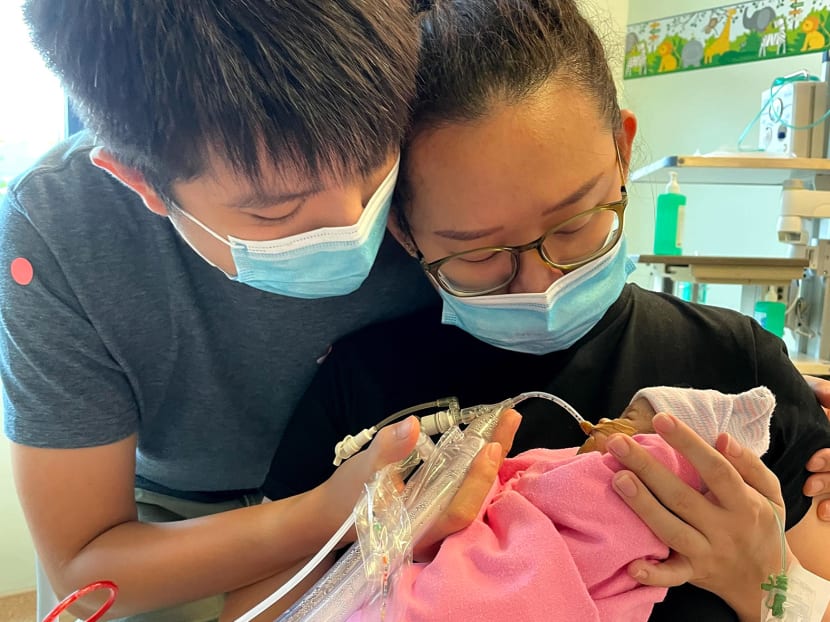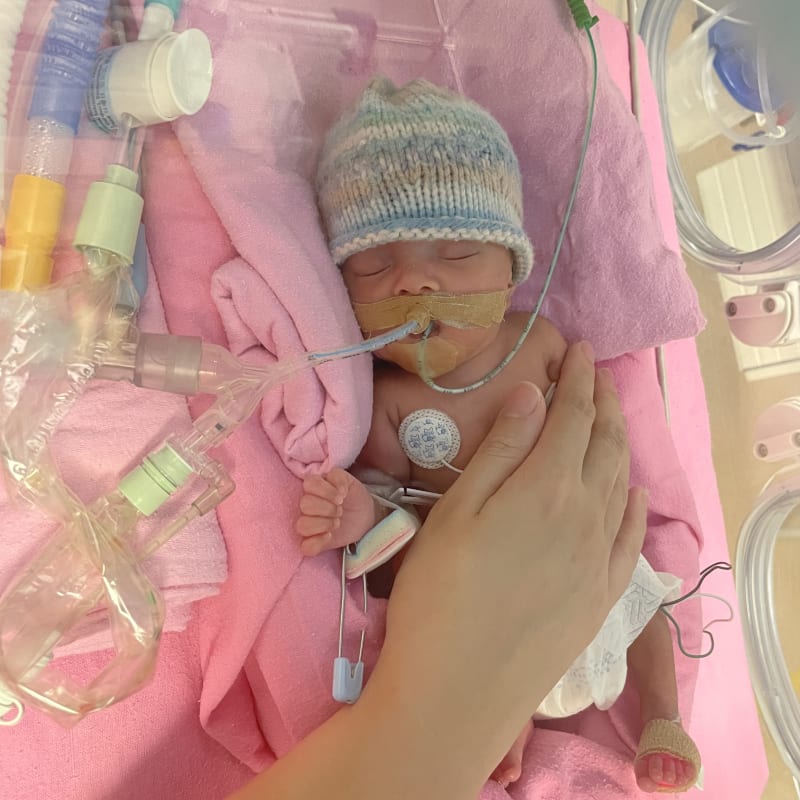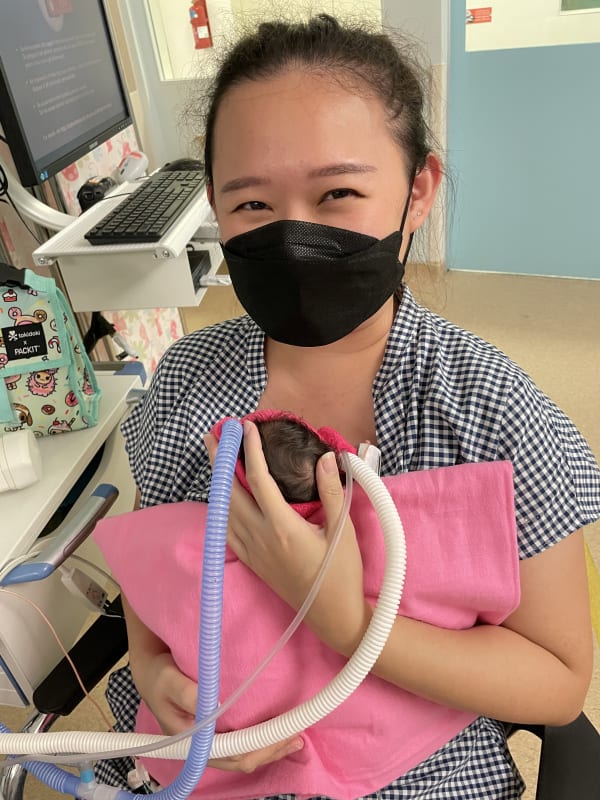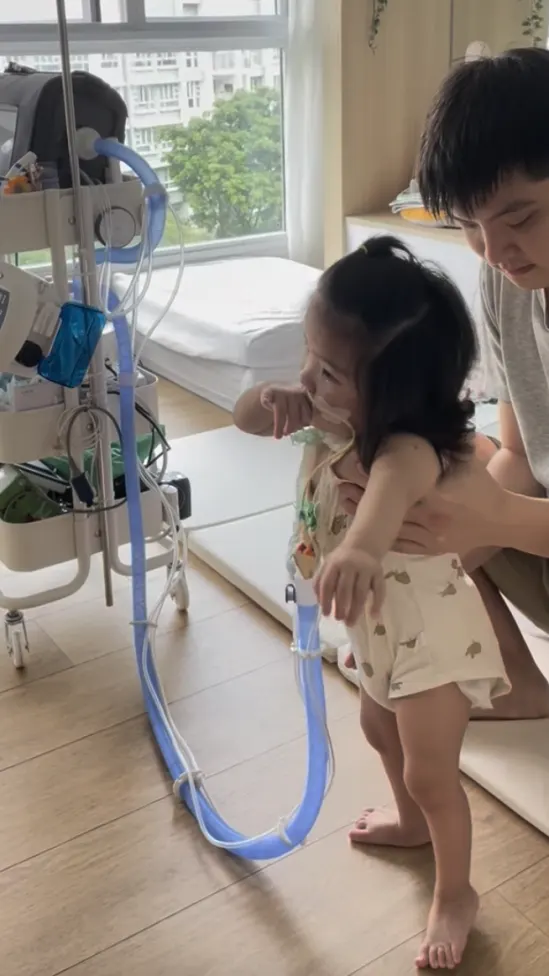The harrowing ordeal of watching our sick child spend her first 429 days fighting for her life in hospital
In 2021, Ms Chua Sze Hwei and her husband Immanuel Goh welcomed baby Laura far earlier than expected, only to spend the next 14 months not knowing if their daughter would live.

Ms Chua Sze Hwei and her husband Immanuel Goh properly carrying baby Laura for the first time when she was two months old. (Photos: Chua Sze Hwei and Immanuel Goh)

This audio is generated by an AI tool.
In 2021, I was 28 weeks pregnant with our first child when we went to get checked for gestational diabetes. It was meant to be a routine test, so our blood ran cold when our gynaecologist looked at us gravely and said: "You need to go to KK Women's and Children's Hospital (KKH) now."
I got admitted right away but at the time, we had no idea that this would turn out to be a four-day fight to keep our baby in my womb.
The doctors tried everything, but our little one was in too much distress and needed to be delivered via an emergency C-section.
What followed was not the birth experience I had imagined it to be.
Our baby's tiny cry was barely audible in the operating theatre. The relief I felt hearing our little one's voice for the very first time was short-lived as the medical team quickly whisked her away – I did not even get to see or touch my child.
My husband, Immanuel, had to wait outside the operating theatre throughout the whole operation, not knowing how the both of us were doing.
Once our baby left the operating theatre, Immanuel immediately followed her to the Neonatal Intensive Care Unit. For those first few hours after giving birth, I couldn't see or be with them – all I could do was lay on the recovery bed, fearing the worst.

At just 29 weeks, our Laura entered the world far earlier than we had expected, her fragile lungs not yet ready for their first breath. She was red and raw, with tubes all around her.
She weighed only 700g and was barely any bigger than my hand.
Words cannot describe the heartbreak we felt as we spent the next several days watching our baby lie helpless in an incubator, unsure when we would be able to touch her, much less carry her.
We could only press our hands against the incubator's see-through cover, hoping the warmth of our hands could reach her.
FIGHTING FOR EVERY BREATH
In the very first week of Laura's life, there was no mincing of words – we were told that she was "very sick" and "might not overcome".
She had severe cystic chronic lung disease, meaning she needed constant respiratory support.
Her first days on Earth were filled with beeping monitors and the steady hum of ventilators, sounds that we would eventually get used to as she relied on these machines for the first few years of life.
The first time we held her, we were preparing to let her go. At only 20 days old, she had already undergone cardiopulmonary resuscitation (CPR) and intensive interventions. Her tiny body was just too sick and frail.
Yet, against all odds, she pulled through that night. And the next. And many, many more tough nights after that.
The next time we got to carry her was 50 days later. After nearly two months, we finally got to have the skin-to-skin contact with our baby that we'd been yearning for as new parents.
Most days, though, it was still too tough for her to be moved from her little bed. All we could do was watch as she gave her best fight, hoping and praying our presence and love were enough to strengthen her somehow.
Day after day, we kept turning up to be at Laura's side, determined to brave this perilous rollercoaster ride together.
Even so, at times, we couldn't help but feel helpless and useless. The challenges just seemed endless – surgery after surgery, procedure after procedure.
THE LONGEST WAIT
For 14 months, the hospital was our second home.
Due to COVID-19 visitation restrictions, we didn't have our usual support system of friends and family. But like a real home, the doctors and nurses became like family, supporting us through every step of Laura's journey.
Our doctors delivered the facts of Laura's reality but always encouraged us to remain hopeful.
Our nurses gave us regular updates on her quirks and antics and when Laura celebrated her first birthday in the hospital, they were right there with us, bearing witness.

Most importantly, Immanuel and I learnt to lean on each other more than ever before, finding strength we did not know we had in ourselves and each other.
After 429 arduous days in the hospital, Laura was finally discharged.
Our hearts overflowed with joy, but there was also apprehension. After more than 14 months in the hospital, we knew that taking her home was going to be a monumental challenge.
LIFE AT HOME
For the first few months of being at home, we couldn't let our guard down.
Laura's tracheostomy tube (linked to the windpipe) and tendency for reflux and vomiting meant nights of constant vigilance. She was always at high risk for choking, so we kept watch over her breathing every minute of every day, even as she slept.
Changing her tracheostomy tube and nasogastric tube was no easy feat and it was the same with managing the rest of her medical supplies and equipment.
In the hardest moments, we felt renewed gratitude for the months of careful, thorough training by KKH's home-care nurses.
As exhausting as it was, having our daughter home with us was everything we'd dreamed of during those long hospital months.
Every gummy smile from her, every peaceful moment of rest we could enjoy together reminded us of how far we had come.
%20crop.jpg?itok=KlKb3MPY)
We had joined a children's tracheostomy group to find support and community with other families going through similar experiences. Even before we got home, we were recommended a trolley setup for her medical equipment that would make caring for her easier.
As Laura grew bigger and more mobile, we sought advice from experienced parents in the group who gave us invaluable suggestions on how to adjust the trolley setup to better accommodate her movement.
We admired their resourcefulness in finding ways to support their children through trial and error, and how they freely shared their wisdom and experience to help other children just like Laura, who were growing in awareness of the tubes and machines as being part of their little lives.
SHARING OUR STORY
Early on, we also found hope through another family's Instagram posts about navigating their child's struggles with the same condition. Soon, we began documenting our own journey on an Instagram account (@raising.rara), recording all the ways Laura was beginning to thrive at home despite her many challenges.
This helped us connect with other families facing similar challenges and soon, other parents began reaching out to us as well, with the same questions and fears we once had.

Whenever we go out in public, we often draw stares from strangers, bewildered or alarmed by Laura's many medical apparatus. Many parents in the same boat share similar stories of grief and frustration with us.
Although we can't speak for every one of these parents, here's what we usually say when asked how we would like strangers to react: Smile at these children, even if your initial response is surprise.
How we as adults respond and react to visible differences matters profoundly.
A simple "Hi" and a friendly wave is more appropriate than "What happened to you?" when interacting with a child.
What we say around and about children greatly affects how they perceive the world. It’s not about manners or semantics; it's language that shapes us as a people.
Children with disabilities and medical needs are aware of their differences – but they're still children. Just like any other child, they're worthy of being treated kindly and gently.
Together, we can create a more compassionate Singapore − one that sees beyond the trappings of medical devices to the beautiful souls they support.
Chua Sze Hwei continues to parent four-year-old Laura with her husband Immanuel Goh. At this year's Singapore Health Inspirational Patient and Caregiver Awards, the couple received the Inspirational Caregiver Award.
If you have an experience to share or know someone who wishes to contribute to this series, write to voices [at] mediacorp.com.sg (voices[at]mediacorp[dot]com[dot]sg) with your full name, address and phone number.











